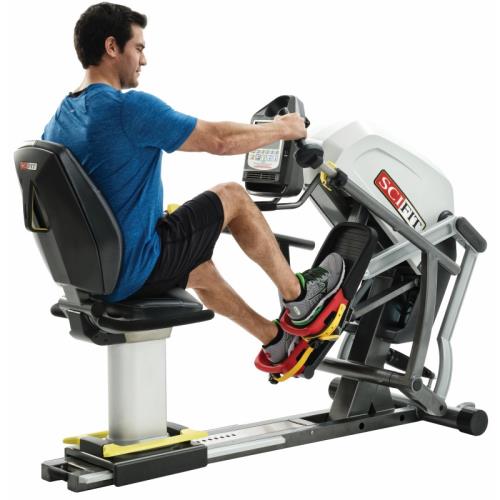Title: The acute effects of high-intensity interval and continuous aerobic exercise on physiological and functional outcomes in persons with multiple sclerosis
Author(s): Hubbard, Elizabeth Anne
Abstract:
BACKGROUND: Multiple sclerosis (MS) is an immune-mediated disease of the central nervous system that results in physiological deconditioning and walking impairments. High-intensity interval training exercise (HIIT) has induced significant improvements in physiological conditioning in healthy and clinical populations. However, the effects of engaging in HIIT on cardiorespiratory functioning, gait, and walking performance in persons with MS who have mobility impairments are relatively unknown.
OBJECTIVES: To examine the effects of single sessions of HIIT and the Canadian Physical Activity Guidelines (CPAG) for aerobic exercise using recumbent stepping on physiological and functional outcomes in persons with MS.
METHODS: 20 participants with mild-to-moderate MS underwent HIIT and CPAG exercise bouts. The HIIT bout included 10 cycles of one minute intervals at the wattage associated with 90% VO2peak followed by one-minute recovery intervals at 15W, totaling 20 minutes in length. The CPAG bout consisted of 20 minutes at the wattage associated with 50-60% VO2peak. All exercise sessions were preceded and concluded by a 5-minute warm-up and cool-down, respectively. Physiological (i.e., power output, oxygen consumption, carbon dioxide expiration, respiratory exchange ratio, ventilation, heart rate, and core temperature) and perceived training session tolerance (i.e., ratings of perceived exertion, arm pain, and leg pain) measures were collected within session, and functional (i.e., walking speed, spatiotemporal aspects of gait, and cognition), mood, and enjoyment measures were collected pre-, immediately-post, and 30-minutes post-exercise. Significant differences between the HIIT and CPAG protocols were determined using a repeated-measures, two-factor analysis of variance with condition (HIIT, CPAG) and time as within subject factors.
RESULTS: The data revealed significant condition time interactions for all physiological measures, ratings of perceived exertion, and leg pain, with differential patterns evident over time for the HIIT versus CPAG conditions (p < .05). The main effect of condition was significant for all physiological outcomes, except core temperature, with the HIIT condition inducing significantly higher values for all physiological outcomes than the CPAG condition (p < .05). Core temperature increased during both conditions, but did not significantly differ by condition (p > .05). There were no significant condition time interactions or main effects of condition on arm pain, walking speed, spatiotemporal aspects of gait, or mood (p > .05). The main effect of time was significant for all physiological measures, perceived training session tolerance measures, all spatiotemporal aspects of gait, cognition, and mood (p < .05), except for anger and depression (p > .05). Walking speed did not significantly differ by time (p > .05). Participants enjoyed the HIIT and CPAG exercise sessions similarly (p > .05).
CONCLUSIONS: The data indicate that HIIT exercise taxes the cardiorespiratory system significantly more than CPAG exercise, yet without sustained deleterious effects on core temperature, walking, gait, cognition, mood, or enjoyment in persons with MS. This has important implications for informing an evidence-based exercise prescription that is appropriate for improving physiological conditioning for a randomized control trial in persons with MS who have walking impairments.

Author(s): Hubbard, Elizabeth Anne
Abstract:
BACKGROUND: Multiple sclerosis (MS) is an immune-mediated disease of the central nervous system that results in physiological deconditioning and walking impairments. High-intensity interval training exercise (HIIT) has induced significant improvements in physiological conditioning in healthy and clinical populations. However, the effects of engaging in HIIT on cardiorespiratory functioning, gait, and walking performance in persons with MS who have mobility impairments are relatively unknown.
OBJECTIVES: To examine the effects of single sessions of HIIT and the Canadian Physical Activity Guidelines (CPAG) for aerobic exercise using recumbent stepping on physiological and functional outcomes in persons with MS.
METHODS: 20 participants with mild-to-moderate MS underwent HIIT and CPAG exercise bouts. The HIIT bout included 10 cycles of one minute intervals at the wattage associated with 90% VO2peak followed by one-minute recovery intervals at 15W, totaling 20 minutes in length. The CPAG bout consisted of 20 minutes at the wattage associated with 50-60% VO2peak. All exercise sessions were preceded and concluded by a 5-minute warm-up and cool-down, respectively. Physiological (i.e., power output, oxygen consumption, carbon dioxide expiration, respiratory exchange ratio, ventilation, heart rate, and core temperature) and perceived training session tolerance (i.e., ratings of perceived exertion, arm pain, and leg pain) measures were collected within session, and functional (i.e., walking speed, spatiotemporal aspects of gait, and cognition), mood, and enjoyment measures were collected pre-, immediately-post, and 30-minutes post-exercise. Significant differences between the HIIT and CPAG protocols were determined using a repeated-measures, two-factor analysis of variance with condition (HIIT, CPAG) and time as within subject factors.
RESULTS: The data revealed significant condition time interactions for all physiological measures, ratings of perceived exertion, and leg pain, with differential patterns evident over time for the HIIT versus CPAG conditions (p < .05). The main effect of condition was significant for all physiological outcomes, except core temperature, with the HIIT condition inducing significantly higher values for all physiological outcomes than the CPAG condition (p < .05). Core temperature increased during both conditions, but did not significantly differ by condition (p > .05). There were no significant condition time interactions or main effects of condition on arm pain, walking speed, spatiotemporal aspects of gait, or mood (p > .05). The main effect of time was significant for all physiological measures, perceived training session tolerance measures, all spatiotemporal aspects of gait, cognition, and mood (p < .05), except for anger and depression (p > .05). Walking speed did not significantly differ by time (p > .05). Participants enjoyed the HIIT and CPAG exercise sessions similarly (p > .05).
CONCLUSIONS: The data indicate that HIIT exercise taxes the cardiorespiratory system significantly more than CPAG exercise, yet without sustained deleterious effects on core temperature, walking, gait, cognition, mood, or enjoyment in persons with MS. This has important implications for informing an evidence-based exercise prescription that is appropriate for improving physiological conditioning for a randomized control trial in persons with MS who have walking impairments.
